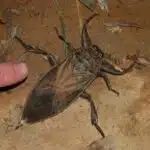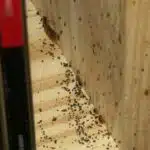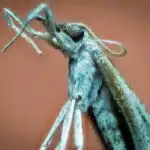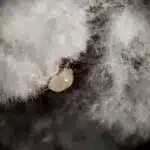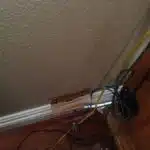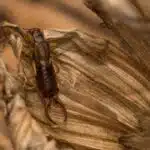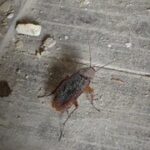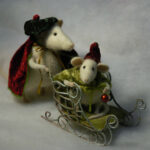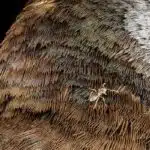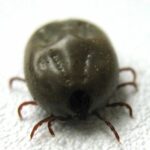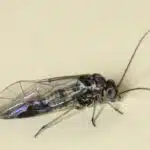Gnats are a common household pest that can be quite bothersome. These small, flying insects can quickly become an annoyance, particularly during the warmer months of the year. Gnats are attracted to moisture and organic matter, making them particularly prevalent in areas such as kitchens and bathrooms. If left unchecked, a gnat infestation can quickly spread throughout your home, causing frustration and discomfort for you and your family.
As a pest control expert with years of experience dealing with gnat infestations in homes across the country, I have seen firsthand the negative impact these pests can have on homeowners. Fortunately, there are several effective strategies that you can use to get rid of gnats in your home once and for all. In this article, I will provide you with detailed instructions on how to identify a gnat infestation in your home, as well as practical tips for eliminating these pests and preventing them from returning in the future. With my help, you’ll be able to keep your home free from gnats and enjoy a more comfortable living space for yourself and your loved ones.
Identifying A Gnat Infestation
The presence of gnats in your home is a common issue that many homeowners face. These tiny flying insects are attracted to moist environments and can breed quickly, causing an infestation if left unchecked. One of the signs of gnat presence is noticing a swarm of small flies around your food or trash cans. If you see these pests in your kitchen or bathroom, it’s likely that you have a gnat infestation.
Gnats prefer damp areas to lay their eggs, such as overripe fruit or vegetables, standing water in sinks, and shower drains. If you notice gnats hovering around these areas, it’s possible that they are breeding there. In addition, gnats can also thrive in houseplants with moist soil. Overwatering plants can create the ideal environment for gnats to reproduce and take over your home.
If you suspect that you have a gnat infestation, it’s important to act quickly to prevent further breeding and spread. Identifying the common breeding areas is the first step towards eliminating this pest from your home. In the next section, we will discuss how understanding the behavior of gnats can help you effectively get rid of them for good.
Understanding The Behavior Of Gnats
- Gnats are classified as small flying insects and can be identified by their wings and long legs.
- There are various species of gnats, including fruit flies, eye gnats, and fungus gnats, and each one has different characteristics and behavior.
- Gnats typically reproduce in moist, damp environments and lay their eggs near sources of food.
- Knowing the type of gnats present, as well as their reproduction habits, is key to developing a successful plan to get rid of them in your home.
Identifying Gnat Species
Gnats can be a frustrating and annoying pest to deal with in your home. Identifying the specific species of gnat that is infesting your space is crucial in understanding their behavior and how to effectively get rid of them. The most common types of gnats found in homes are fungus gnats, fruit flies, and drain flies.
Fungus gnats typically have a shorter life cycle compared to fruit flies and drain flies, which makes them easier to control. They prefer damp soil or decaying organic matter as their habitat preference. On the other hand, fruit flies are attracted to ripening fruits and vegetables, while drain flies prefer stagnant water or sewage systems.
Depending on the species of gnat you are dealing with, different gnat control products may be more effective than others. For example, fly traps with sticky surfaces may work well for catching fruit flies, while using larvicide treatments in standing water can help control drain fly populations. It is important to understand the life cycle and habits of the specific gnat species you are dealing with in order to choose the most effective control methods.
In conclusion, identifying the type of gnat species that is causing an infestation in your home is vital for understanding their behavior and choosing effective gnat control products. By knowing their habitat preferences and life cycle, you can take targeted steps towards eliminating these pesky pests from your living space.
Understanding Gnat Reproduction Habits
Understanding the behavior of gnats is crucial in effectively controlling their infestation in your home. One aspect that needs attention is their reproduction habits. Gnats reproduce rapidly, and understanding their breeding sites and life cycle stages can help identify effective control methods.
Gnats have different breeding sites depending on their species. Fungus gnats breed in moist soil or decaying organic matter, while fruit flies lay eggs on ripening fruits and vegetables. Drain flies prefer stagnant water or sewage systems for laying their eggs. Understanding these breeding sites allows for targeted control methods to be implemented.
Controlling gnat populations can be done through biological or chemical methods. Biological methods involve introducing predators such as nematodes or predatory mites to eliminate gnat larvae. Chemical methods include using insecticides that target adult gnats or using larvicides to kill gnat larvae in breeding sites. Understanding the life cycle stages of the specific gnat species infesting your home is important in choosing the most effective control method.
Types Of Gnats And Their Characteristics
Moving on from understanding the behavior of gnats, it is important to identify the types of gnats that might be infesting your home. Different types of gnats have different breeding habits, which can help in controlling their population. For example, fungus gnats breed in moist soil, while fruit flies lay eggs on overripe fruit. Once you have identified the type of gnat, you can take appropriate measures to control their population.
Identifying breeding sites is crucial when trying to get rid of gnats in your home. Gnats are attracted to moist and decaying organic matter, such as fruits, vegetables, and damp soil. Therefore, it is essential to remove any overripe or spoiled produce from your kitchen and dispose of it properly. Additionally, keeping your home clean and free from standing water can prevent gnats from breeding.
There are several control measures that you can implement to get rid of gnats in your home. These include using sticky traps to catch adult gnats or applying insecticides that target specific types of gnats. It is also important to seal any cracks or crevices where gnats might be entering your home. By taking these steps, you can effectively control the population of these pesky pests in your living space.
Moving forward, it is important to address the health risks associated with gnats in your home. While they may seem harmless at first glance, some species of gnats are capable of transmitting diseases such as bacteria and viruses through their bites or contact with contaminated surfaces. Therefore, it is imperative that you take steps to eliminate their presence from your living space and prevent them from returning in the future.
Health Risks Associated With Gnats
Gnats may seem like harmless insects flying around your home, but they can actually pose serious health risks to you and your family. Gnats are known to carry disease-causing organisms that can be transmitted to humans. These organisms include bacteria, viruses, and parasites that can cause illnesses such as food poisoning, diarrhea, and skin infections.
To prevent gnat borne illnesses in your home, it is important to take certain precautions. Firstly, keep your home clean and free of rotting or decaying organic matter such as fruit peels or moist soil. This will reduce the likelihood of gnats breeding in your home. Secondly, ensure that all food items are stored properly in sealed containers to prevent gnats from contaminating them with disease-causing organisms. Lastly, repair any leaking pipes or faucets in your home as standing water can attract gnats.
It is also important to recognize the signs of a gnat infestation in your home. These signs include seeing large numbers of gnats flying around indoors or noticing small black specks on surfaces around the house. If you suspect a gnat infestation in your home, it is recommended to contact a pest control expert who can help identify the source and provide effective treatment options.
Ultimately, preventing gnat borne illnesses requires diligence in keeping your environment clean and free from potential breeding grounds for these insects. In the next section, we will discuss how cleaning and sanitizing your home can effectively eliminate gnats from your living space.
Cleaning And Sanitizing Your Home
In order to properly clean and sanitize a home, it is important to start with surfaces. These should be thoroughly wiped down and vacuumed to remove any food residue, dirt and other matter that could attract gnats.
Fabrics should also be disinfected with a disinfectant spray or a steam cleaner. This will help to eliminate any existing gnats and discourage them from breeding.
To prevent gnats from breeding, it is important to identify and eliminate any potential breeding sites in the home. These may include standing water, unemptied garbage cans, and food debris in drain traps.
Additionally, all food items should be properly sealed and stored away from potential gnat entry points.
Windows and doors should also be screened to prevent infestation from outside sources.
Finally, it is important to keep the home clean and clutter-free to discourage gnats from settling in.
Cleaning Surfaces
DIY cleaning is a great way to get rid of gnats in your home. One of the most important things to do when cleaning surfaces is to remove any moisture. Gnats are attracted to moist areas, so wiping down surfaces with a dry cloth can help prevent them from congregating. Additionally, it’s important to regularly clean up spills and crumbs that may have accumulated on counters and floors.
While DIY cleaning can be effective, sometimes professional cleaning services are necessary for more severe gnat infestations. Professional cleaners have access to specialized equipment and products that can eliminate gnats quickly and efficiently. They also have the expertise needed to identify potential problem areas in your home, such as leaky pipes or poorly sealed windows.
When it comes to keeping gnats out of your home, prevention is key. Regularly cleaning surfaces and eliminating sources of moisture will go a long way towards preventing gnats from taking up residence in your house. However, if you find yourself dealing with a particularly stubborn infestation, don’t hesitate to call in the professionals for assistance. With the right approach, you can get rid of those pesky gnats once and for all!
Disinfecting Fabrics
When it comes to cleaning and sanitizing your home, it’s important not to overlook fabrics. Fabrics can harbor bacteria and other harmful pathogens that can contribute to illness or allergies. Disinfecting fabrics is an essential part of any comprehensive cleaning regimen. Steam cleaning is a highly effective way to disinfect fabrics, as the high temperatures kill bacteria and other pathogens on contact.
If you don’t have access to a steam cleaner, a vinegar solution can also be used to disinfect fabrics. Simply mix equal parts vinegar and water in a spray bottle and apply directly to the fabric. Allow the solution to sit for several minutes before wiping away with a clean cloth. Vinegar has natural antibacterial properties that make it an effective disinfectant.
When disinfecting fabrics, it’s important to pay special attention to high-touch areas such as couch cushions, pillows, and bedding. These areas are more likely to harbor bacteria and other pathogens due to frequent contact with human skin. By regularly steam cleaning or using a vinegar solution on these areas, you can help keep your home free from harmful bacteria and other germs.
Eliminating Breeding Sites
As a pest control expert, it is important to address the issue of gnats and their breeding sites when it comes to cleaning and sanitizing your home. Gnats are often attracted to moist areas, so eliminating potential breeding sites can help prevent infestations. Some common breeding sites for gnats include standing water in sinks or drains, over-watered indoor plants, and damp soil in potted plants.
To eliminate breeding sites for gnats, start by regularly checking your sinks and drains for standing water. Be sure to wipe down any excess moisture around the sink after use. Additionally, make sure to avoid over-watering indoor plants and check the soil regularly for signs of excess moisture. If necessary, consider repotting plants with fresh soil that has better drainage.
When it comes to outdoor areas such as trash cans or compost piles, be sure to empty them regularly and keep them covered tightly when not in use. By taking these steps to eliminate potential breeding sites for gnats, you can help prevent infestations in your home and keep your living space clean and sanitary.
Removing Moisture Sources
Moisture is the lifeblood of gnats. Without it, these pesky insects cannot survive. So, if you want to get rid of them, why not give them what they need? That’s right; let’s create a gnat oasis in your home! Just kidding. The key to eliminating gnats is to remove their sources of moisture.
The first step in removing moisture sources is dehydration prevention. Start by fixing any leaks or drips in your home, including faucets, pipes, and appliances like air conditioners and refrigerators. Wipe down wet surfaces immediately after use and use a dehumidifier to reduce humidity in rooms where gnats are prevalent. Also, make sure to empty and clean all pet water dishes regularly.
Air circulation improvement is another important factor in removing moisture sources. Open windows and doors as much as possible to increase airflow throughout your home. Use fans or air purifiers to help circulate air in stagnant areas like bathrooms or basements. Additionally, avoid overwatering indoor plants and be sure to keep soil surfaces dry.
Now that we’ve discussed the importance of removing moisture sources let’s move on to trapping and killing those pesky gnats. But before we do that let’s make sure we have taken care of all possible moisture sources so that our efforts are not wasted.
Trapping And Killing Gnats
Trapping and killing gnats can be a challenging task, but it is essential to eliminate these pests from your home. There are different methods that you can use, including DIY gnat traps and insecticide-free solutions. These methods are not only effective but also environmentally safe and pet-friendly.
DIY gnat traps are a cost-effective solution that you can use to trap and kill gnats. You can make them using common household items such as apple cider vinegar, dish soap, or beer. For instance, mix apple cider vinegar and dish soap in equal parts in a bowl or jar, then cover it with plastic wrap and poke holes on top. Gnats will be attracted to the mixture’s scent and get trapped inside the jar or bowl.
Insecticide-free solutions are another effective way of getting rid of gnats in your home. Consider using natural repellents like peppermint oil, cinnamon sticks, or citrus fruits. These repellents have strong scents that repel gnats without harming them, making them an ideal option for pet owners or anyone who prefers eco-friendly solutions over chemical insecticides.
Transition: While DIY gnat traps and insecticide-free solutions work well to control gnats’ population in your home, there are still other natural remedies that you can use to keep these pests at bay.
Natural Remedies For Gnat Control
Trapping and Killing Gnats is an effective way to control their population, but natural remedies can be a better option for those who want to avoid chemicals. Herbal remedies are a popular choice because they are easy to make and use, and they are generally safe for pets and people. Some of the most commonly used herbs for gnat control include lavender, peppermint, eucalyptus, and basil.
Lavender is one of the most effective herbal remedies for gnats because it has a strong scent that repels them. To use lavender as a gnat repellent, you can place dried lavender in sachets or sprinkle lavender essential oil around your home. Peppermint oil is another effective remedy that you can use to get rid of gnats. Mix some peppermint oil with water and spray it around your home to keep gnats away.
DIY traps are another option for those who want to get rid of gnats naturally. These traps are easy to make using simple household items like vinegar, sugar, wine, or fruit juice. One popular DIY trap involves mixing apple cider vinegar with dish soap in a bowl covered with plastic wrap with small holes poked into it. The gnats will be attracted by the vinegar smell but will get stuck in the soapy mixture when they try to land on it.
Natural remedies like herbal sprays and DIY traps can be very effective at controlling gnat populations in your home. However, if these methods do not work or if you have a severe infestation problem, you may need to consider using chemical insecticides as a last resort. In the next section, we will discuss how chemical insecticides work and how they should be used safely to get rid of gnats in your home.
Using Chemical Insecticides
Chemical insecticides are a common method for getting rid of gnats in your home, but it’s important to use them safely and effectively. One option is to use a spray specifically designed for gnats or fruit flies. These products usually contain pyrethrin or permethrin, which are toxic to insects but safe for humans and pets when used as directed.
Another option is to use a fogger or bug bomb. These products release a mist of insecticide throughout the room, eliminating any gnats that come into contact with it. However, they can be dangerous if not used properly. Be sure to follow the instructions carefully, and evacuate the area for the recommended amount of time.
Alternatives to chemical insecticides include natural remedies like apple cider vinegar traps or essential oil sprays. While these methods may not be as effective as chemical products, they can be safer and more environmentally friendly.
Safety considerations for using chemical insecticides include wearing gloves and protective clothing when handling them, keeping them away from children and pets, and making sure the room is well-ventilated during and after application. It’s also important to read the label carefully for specific instructions on how much product to use and how long to leave it on surfaces.
Preventing gnat infestations in the future requires proper sanitation practices such as keeping surfaces clean, storing food in sealed containers, and disposing of overripe fruits promptly. Additionally, fixing any water leaks or sources of standing water can eliminate breeding grounds for gnats. By taking these preventative measures, you can reduce your reliance on chemical insecticides and keep your home gnat-free.
Preventing Gnat Infestations In The Future
By using chemical insecticides, you can eradicate gnats from your home. However, it is important to note that these chemicals can be harmful to humans and pets if not used properly. Therefore, it is essential to read the labels carefully before using any pesticide products. It is also recommended to wear protective clothing and use a mask while applying insecticides indoors.
If you prefer DIY methods, there are many natural remedies that can help get rid of gnats in your home. For example, apple cider vinegar traps and sticky tape can capture adult gnats effectively. Moreover, cleaning your drains with baking soda and vinegar every week can prevent gnat larvae from growing in stagnant water.
Hiring experts for pest control services is another option if you are unable to eliminate gnats on your own. Pest control professionals have the necessary tools and expertise to identify the source of the infestation and provide effective treatments accordingly. They also use safer insecticides that are less harmful to humans and pets compared to over-the-counter products.
Proper food storage and disposal are crucial in preventing future gnat infestations. Make sure all fruits and vegetables are stored in sealed containers or refrigerated. Additionally, clean up any spills or crumbs immediately after eating, as they attract gnats. Lastly, dispose of trash regularly and keep compost bins covered tightly to avoid creating breeding grounds for gnats. By following these preventative measures, you can keep your home gnat-free for good!
Proper Food Storage And Disposal
Proper food storage and disposal are crucial in eliminating gnats from your home. Gnats are attracted to overripe and decaying fruits and vegetables, as well as moist organic matter such as food scraps left in the sink or garbage can. To prevent gnats from infesting your home, it is essential to store food properly by keeping it sealed in airtight containers or in the refrigerator. This will reduce the likelihood of attracting gnats to your pantry or kitchen.
Additionally, proper disposal techniques must be utilized when getting rid of food scraps and trash. It is important to dispose of any waste promptly, especially those that contain food particles. Avoid leaving them in the garbage can for extended periods, as this can attract gnats and other pests to your home. Make sure to seal your garbage bags before disposing of them and clean out your garbage can regularly.
By practicing proper food storage and disposal techniques, you can significantly reduce the presence of gnats in your home. Not only will this eliminate the nuisance caused by these pests but also help maintain a healthy living environment for you and your loved ones. In the next section, we will discuss how repairing leaks and sealing cracks can further aid in preventing gnat infestations.
Repairing Leaks And Sealing Cracks
Proper food storage and disposal is an essential step in preventing gnats from infesting your home. However, even with the best practices, gnats may still find their way inside. One of the ways to get rid of gnats is by waterproofing surfaces and caulking gaps.
Waterproofing surfaces prevents moisture buildup, which attracts gnats. You can use special waterproofing paint or sealant to cover surfaces like sinks and countertops. Additionally, repairing leaky pipes and faucets is important as it eliminates any potential sources of standing water that could attract these pests.
Caulking gaps around windows, doors, and walls also helps prevent gnats from entering your home. These tiny openings provide entry points for the insects, so sealing them off will help keep them out. Use a high-quality caulk that won’t shrink or crack over time for maximum effectiveness.
Incorporate these four steps into your pest control routine to eliminate gnats completely:
- Clean up spills immediately
- Wipe down counters frequently
- Keep garbage cans tightly sealed
- Store fruits and vegetables in the refrigerator
By following these steps and regularly maintaining a clean and dry home, you can prevent future gnat infestations from occurring. In addition to waterproofing surfaces and caulking gaps, these preventative measures will ensure that your home remains pest-free in the long run.
Maintaining A Clean And Dry Home
A common reason for gnats to infest homes is the presence of moist areas. Therefore, it is essential to maintain a dry home to prevent gnat infestation. One way to do this is by organizing clutter and keeping your home tidy. Cluttered areas provide hiding spaces for gnats, making them difficult to get rid of. Make sure that you throw away any unnecessary items and store things in proper storage containers.
Another effective way to keep gnats from invading your home is by using essential oils. Gnats are repelled by the strong scents of certain essential oils such as lavender, peppermint, and eucalyptus oil. Mix a few drops of these oils with water and spray it around your house. This method not only repels gnats but also leaves a pleasant scent in the air.
In addition to organizing clutter and using essential oils, keeping your home dry is crucial in preventing gnat infestation. Be sure to fix any leaky pipes or faucets as well as check for any moisture buildup in areas like bathrooms or kitchens. By following these steps, you can maintain a clean and dry home, which will significantly reduce the chances of attracting gnats.
To fully eradicate gnats from your home, seeking professional pest control services may be necessary. These experts have access to specialized equipment and knowledge on how to locate gnat breeding grounds effectively. Furthermore, they can use safe yet potent insecticides that will eliminate gnats without posing any harm to humans or pets living in your home.
Seeking Professional Pest Control Services
Professional Pest Control Services: Because Sometimes DIY Just Doesn’t Cut It
So, you’ve tried every home remedy and store-bought solution to get rid of gnats in your home. You’ve spent hours on end trying to catch the little buggers and yet, they still persist. Maybe it’s time to call in the big guns. Seeking professional pest control services can be a game changer when it comes to getting rid of gnats for good.
Benefits of Professional Pest Control Services
- Expertise: Professional pest control companies have trained experts who understand the behaviors and habits of different pests, including gnats. They know how to identify their breeding grounds, eliminate them at the source, and prevent future infestations.
- Safety: Many DIY solutions involve harsh chemicals or traps that can be dangerous for humans and pets if not used correctly. Professionals have access to safer and more effective methods that are tailored to your specific situation.
- Cost effectiveness: While hiring a professional may seem like an added expense, it can actually save you money in the long run. Continuously buying products that only provide temporary relief can add up over time. A professional will provide a thorough assessment and treatment plan that addresses the root cause of the problem.
As a pest control expert, I highly recommend seeking professional help when dealing with persistent gnat problems in your home. Not only do professionals have the knowledge and resources necessary to get rid of them for good, but they also offer peace of mind knowing that your home is safe from harmful chemicals and potential health risks.
In conclusion, if you’re tired of constantly battling gnats in your home, consider enlisting the help of a professional pest control company. With their expertise, safety measures, and cost-effective solutions, you’ll finally be able to say goodbye to those pesky bugs once and for all!
Conclusion: Say Goodbye To Gnats For Good!
Having a gnat infestation in your home can be both annoying and frustrating. However, there are several ways to get rid of these pesky insects. In the previous section, we discussed how seeking professional pest control services can help you eliminate gnats from your home. In this section, we will explore two other effective methods for dealing with gnats: long-term prevention and DIY gnat traps.
Long-term prevention is a crucial step in ensuring that gnats do not return to your home. One way to prevent them from entering your house is by keeping it clean and dry. Gnats thrive in damp environments, so be sure to fix any leaking pipes or faucets and wipe down any standing water on surfaces. Additionally, avoid over-watering indoor plants and make sure that your garbage cans have tight-fitting lids.
DIY gnat traps are another effective method for getting rid of these pests. There are several simple yet effective traps that you can make using common household items such as vinegar or apple cider vinegar, dish soap, and plastic wrap. These traps work by attracting gnats with the scent of vinegar or fruit juice and trapping them in the solution. By regularly emptying the trap and replacing it with a fresh one, you can significantly reduce the number of gnats in your home.
By implementing long-term prevention methods and using DIY gnat traps, you can effectively get rid of gnats in your home without having to rely on professional pest control services. Remember to keep your environment clean and dry while also taking advantage of easy-to-make gnat traps for maximum effect. With these tips, you’ll be saying goodbye to gnats for good!
Conclusion
Gnats can be a frustrating and persistent problem in any home, but with the right approach, they can be eliminated. Identifying the type of gnat infestation and understanding their behavior is crucial to developing an effective removal plan. Sanitizing your home and repairing any leaks or cracks that may be attracting gnats is essential. It’s important to maintain a clean and dry living environment to prevent future infestations.
There are several types of gnats, each with unique characteristics that require specific treatment methods. Drain flies thrive in damp areas like sinks and drains while fungus gnats are commonly found in moist soil. Additionally, fruit flies gravitate towards overripe fruits and vegetables left out on countertops.
Gnats can pose health risks such as transmitting diseases or irritating allergies. Therefore, it’s essential to take swift action when dealing with an infestation.
While some home remedies may offer temporary relief, seeking professional pest control services is the most effective way to eliminate gnats for good. Pest control experts have the necessary tools and knowledge to identify the root cause of an infestation and apply targeted treatments to eradicate it completely.
In conclusion, getting rid of gnats in your home requires identifying the type of infestation you have, maintaining a clean living environment, repairing leaks and sealing cracks, and seeking professional pest control services if necessary. By following these steps, you can eliminate gnats from your home for good and enjoy a comfortable living space free from pesky insects. Remember that taking action at the first sign of an infestation is crucial to preventing further health risks or damage to your property.
Image Credits
- “Gnat!” by Richard Masoner / Cyclelicious (featured)


